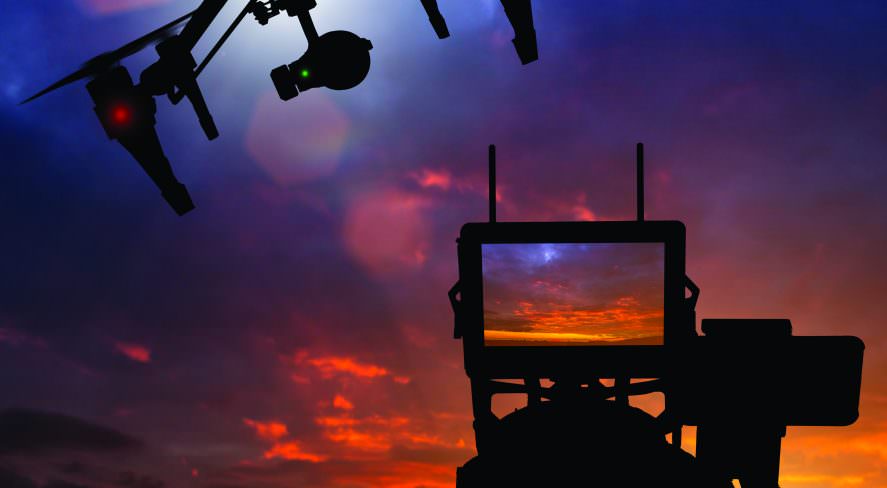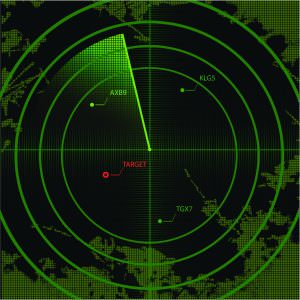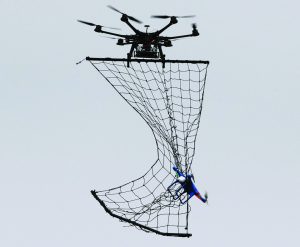Threat from Above

How can potentially dangerous drones be detected and defeated?

Logan Harris, SpotterRF
Unmanned aerial vehicles (UAVs), or drones, have been in use for many years but had not been widely adopted by the mass market until recently. With that adoption has come many new and productive applications of drones, but new threats have also emerged in a wide variety of areas. For example:
- “The Pentagon has seen both commercially bought quadcopters and fixed-wing type unmanned aircraft systems used in an improvised manner to both deliver IEDs and for reconnaissance,” Joint Improvised-Threat Defeat Agency spokesman David Small wrote in a July 6 email to Inside the Pentagon.
- In 2015, 21 drone sightings were reported to the U.S. Fire Administration in Arizona alone and nine of those forced the grounding of firefighting aircraft.
- According to sports security experts, finding a football game without a drone is now the exception. How long before one disperses a chemical or biological agent over a crowd of 50,000 or more fans?
- In 2014, the Federal Energy Regulatory Commission reported that destroying as few as nine electrical substations could take out the entire U.S. power grid for more than one year. How long before terrorists try launching a coordinated attack using low-cost drones?
- According to a recent report by Open Briefing, a London-based civil society intelligence agency, some drones are capable of carrying payloads of as much as 1,000 kg of explosives, which is more than three times the amount said to have been used by al Qaida to bomb the U.S.S. Cole in October 2000. How long before a terrorist delivers such a payload to a nuclear power plant or a busy bridge carrying 200,000 cars per day?
Because of the potentially disastrous consequences posed by improper drone use, there has been a recent upsurge in the development of technology that can be used to mitigate drone threats, though many of the approaches have not yet been approved by the Federal Aviation Administration (FAA).
Technology Solutions
Geofencing of Commercial Drones
Drone manufacturers are now embedding programs into their drones that do not permit them to fly above areas such as airports and the White House. However, these can be easily circumvented by disabling the GPS and flying under manual control.
There are many companies that use a variety of technologies to detect, identify and respond to drone events. Each of these technologies has pros and cons.
The first step in the security workflow is to detect the threat. There are four main types of sensors that are being used to detect drones.
Video
Cameras, both optical and thermal, are limited by a very narrow field of view (less than 4 degrees for detection out to 300 meters) in order to get enough pixels on target to detect that there is a drone in the area. Plus, environmental conditions such as rain, fog, snow or dust can severely affect camera performance. Combining different lighting conditions and video analytics, cameras are unable to reliably detect a drone outside of very short ranges (less than 100 meters).
Acoustic Sensors
Acoustic sensors listen for the sound that a drone makes. In certain quiet conditions, these sensors have proven to be successful in detecting particular types of drones within a 50 to 100 meter radius, but they are unable to precisely determine the location. Acoustic sensor effectiveness is significantly reduced when rain or snow is falling because the sound from the drone is obscured. This same effect occurs with background noise, such as in urban environments.
Radio Sensors
Radio sensors listen for the radio communication between a drone and its controller. Because drones are able to operate autonomously with no communication to the controller, however, radio sensors are not always able to detect them. Another limitation of radio sensors is that they have to recognize the unique type of communication that occurs for each and every make and model of drone, which means there will always be drones that the radio sensors do not recognize. The benefit of radio sensors is that they are able to cover wide areas, as long as there are not a lot of other radio transmitters in the area; otherwise, the radio signal of the drone can be lost among all of the background signals.
Radar
 Radar has been used since World War II to detect airborne objects at long ranges and over wide areas. Radar is not affected by weather conditions and does not require there to be any communication between a drone and its operator. However, radar in the past was designed to detect fast-moving planes, not small drones that are moving very slow and low. For this type of older radar, the drones are just background clutter that is rejected. Recently, though, a new class of radar has arisen called compact surveillance radar (CSR), which picks up small, slow-moving targets and provides precise location information about them. These small radar devices can be pointed up at the sky so that they do not pick up ground clutter. A limitation of CSR is that it will also detect and track birds, which increases the number of false detections. New artificial intelligence algorithms, however, have been successfully applied to train systems to recognize the difference between birds and drones.
Radar has been used since World War II to detect airborne objects at long ranges and over wide areas. Radar is not affected by weather conditions and does not require there to be any communication between a drone and its operator. However, radar in the past was designed to detect fast-moving planes, not small drones that are moving very slow and low. For this type of older radar, the drones are just background clutter that is rejected. Recently, though, a new class of radar has arisen called compact surveillance radar (CSR), which picks up small, slow-moving targets and provides precise location information about them. These small radar devices can be pointed up at the sky so that they do not pick up ground clutter. A limitation of CSR is that it will also detect and track birds, which increases the number of false detections. New artificial intelligence algorithms, however, have been successfully applied to train systems to recognize the difference between birds and drones.
A new class of radar has arisen called compact surveillance radar (CSR), which picks up small, slow-moving targets and provides precise location information about them.
Identification or Classification
The next step in the threat response chain is to identify or classify the nature of the threat. While acoustics, radar and radio are able to detect a drone, it is difficult for these technologies to provide much information on the nature of the threat that the drone may present. For instance, is the drone carrying a camera or other payload? Is it a hobby drone or one with a larger payload?
If precise location information is known, then an optical/thermal camera can be used to evaluate the threat. Using cameras with sufficient zoom and resolution allows an operator to identify the type of drone and any payload that is visible. High-quality continuous zoom thermal cameras have the best contrast and image capability across both day and night operations.
Various mechanisms can be used to alert an operator that a drone is in restricted airspace. These methods include pointing a laser dazzler or spotlight at the drone, which requires an accurate real-time location reading. If the drone continues into the restricted area, then it can be inferred that the operator has ill intent and is not just an uninformed hobbyist. A higher-level response is then warranted.

Response
There are a number of ways to respond to drones, ranging from shooting them out of the air to jamming their communication link and GPS.
Some are considerably easier to accomplish than others, and legal advice should always be sought before purchasing or deploying any solutions.
Kinetic
Shooting a drone is viable at ranges of less than 100 meters. Beyond that, it is very difficult to aim a rifle or shotgun precisely enough to damage the drone. One must also consider the liability and legal issues related to firing a weapon at a drone, which includes responsibility for wherever the discharged rounds may end up. In most cases, this type of response is illegal.
An alternative to a shotgun is a net gun that shoots a net to envelope a drone. The main limitations of this method are range and accuracy. The farthest that these guns can shoot a net is 100 meters, and hitting a moving target with one is very difficult. However, for short-range stationary drones, net guns can be effective.
Drone vs. Drone
Drone wars can be fun to watch but they are not very practical. It is very difficult to fly a drone into another drone, especially when the other drone is moving at a high rate of speed and is trying to avoid the attacking drone. Also, given FAA regulations stating that all commercial drones must only be flown within line of sight of the operator, it is very difficult to scale this solution at this time. This option may develop in the future as regulations change and on-board drone sensing capabilities improve.
GPS Spoofing
Another electronic response method is to make the drone’s GPS receiver think that it is much higher than it is. The drone then drops down to a lower altitude and comes in contact with the ground. The problem with GPS spoofing is that it could also affect the GPS receivers of other devices. GPS spoofing devices are still very much in the R&D phase and are not something that can be purchased at this time.
Hacking
 Hacking a drone’s communication link has been done with a number of commonly used drones that have unencrypted communications. Commands can be sent to the drone to return home or land. While effective for some drones, the rapidly changing protocols and the addition of encryption to drone communications mean that there will always be drones that cannot be intercepted by this method. Some companies are starting to offer these systems commercially, but they have a limited number of drones that they are able to intercept.
Hacking a drone’s communication link has been done with a number of commonly used drones that have unencrypted communications. Commands can be sent to the drone to return home or land. While effective for some drones, the rapidly changing protocols and the addition of encryption to drone communications mean that there will always be drones that cannot be intercepted by this method. Some companies are starting to offer these systems commercially, but they have a limited number of drones that they are able to intercept.
Jamming
Currently, all drones rely on either a communication link or GPS for navigation. The frequencies used for communication and video are typically in the WiFi bands of 900 MHz, 2.4 GHz and 5.7 GHz. If precise location information is known, the communication link can be jammed with a focused beam of energy that is not dangerous to people or other devices. This type of jamming has been shown to be effective up to ranges of 1 kilometer. Once a drone loses its communication link, the default action is typically to return to where it took off. This allows security personnel to follow the drone and, possibly, find the drone operator. This method is effective against all drones and knowledge of the exact model is not required. There are a number of jamming systems that are commercially available where regulations permit.
GPS jamming should only be used as a final resort after attempts to jam the communication link have failed and the drone is considered an immediate threat. GPS jamming is similar to communication link jamming but at the GPS frequencies of 1.575 GHz and 1.227 GHz. When a drone loses its GPS lock, it will attempt to find its way back home using a digital compass or will, in many cases, just land. The main drawback to jamming GPS is that this may interfere with other aircraft that are in the area. When using an antenna that focuses the beam, the chance of this happening is greatly reduced, but the possibility remains, so this method should only be used as a last resort and when other aircraft are not in the vicinity.
Locate the Operator
The most common response method at this time is to find the drone’s operator. The FAA even has a reference card to be used by law enforcement officers who make contact with a drone operator.
While this method is legal and does not require any specialized technology, it can be difficult to put into practice and it will not prevent a drone from causing damage, as a drone operator usually cannot be located until after the fact.
What Needs to Be Done
Besides the technological questions, there are many regulatory and legal issues surrounding the interception of drones.
How to respond to drones is still very much up in the air because of countries’ differing regulations about restricting interference with aircraft or other electronic equipment. In the United States, it has been illegal to intercept drones, though there have been instances of civilians shooting down drones that were over their property and not being prosecuted. In July, President Obama signed into law H.R. 636, which, among other things, authorizes the FAA to conduct a pilot program on drone countermeasures. It is expected that the FAA will use a number of detection, classification and response mechanisms to counteract drones around airports and other critical infrastructure. In general, however, it is not legal for even state or local governments to stop or interfere with drones, other than by locating the operator and having him or her land the drone. Often, this is not effective, as has been seen in the western United States, where drones have interfered with airborne firefighting efforts and have cost the government millions of dollars. Because of this, in July, Utah passed legislation authorizing firefighters to disable drones flying around active wildfires.
This is just one of many such state laws that will likely be passed, and some may be in conflict with federal regulations. What is needed is a comprehensive FAA rule regarding permissible responses to drones around critical infrastructure.
Logan Harris (lcharris@spotterrf.com) is the CEO of SpotterRF (www.spotterrf.com).
